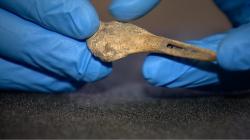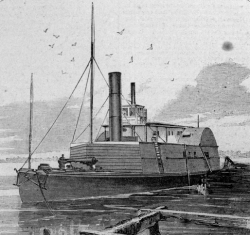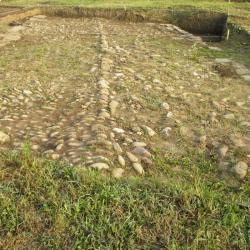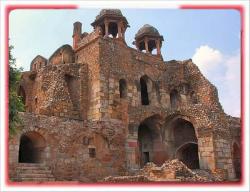INSTITUT SUPERIEUR D'ANTHROPOLOGIE
INSTITUTE OF ANTHROPOLOGY
ONLINE COURSES / COURS A DISTANCE
SUMMER TERM : JULY 2014
REGISTER NOW
ROYAUME UNI – 
 East Lothian -It looked like a cross between a seagull and a penguin and plied the waters off the coast of Scotland until the last member of its species disappeared more than 100 years ago. Now archaeologists say the Great Auk was also a hit with medieval Scottish diners, after a piece of wing bone was unearthed during a dig at the Scottish Seabird Centre, East Lothian. The 3ft-tall flightless seabird, which ranged across northern Europe and America, was a favoured food source in medieval times and was comparatively easy to catch. It was wiped out by human hunters and was driven to extinction in the mid 19th century. Tom Brock, chief executive of the Scottish Seabird Centre, said: "The discovery of the Great Auk bone on site at the Scottish Seabird Centre is fascinating but also very sad. "We are so fortunate in Scotland to have a rich variety of seabirds and we must now use the extinction of the Great Auk as a warning to future generations to look after our wonderful wildlife and the marine environment as an absolute priority."
East Lothian -It looked like a cross between a seagull and a penguin and plied the waters off the coast of Scotland until the last member of its species disappeared more than 100 years ago. Now archaeologists say the Great Auk was also a hit with medieval Scottish diners, after a piece of wing bone was unearthed during a dig at the Scottish Seabird Centre, East Lothian. The 3ft-tall flightless seabird, which ranged across northern Europe and America, was a favoured food source in medieval times and was comparatively easy to catch. It was wiped out by human hunters and was driven to extinction in the mid 19th century. Tom Brock, chief executive of the Scottish Seabird Centre, said: "The discovery of the Great Auk bone on site at the Scottish Seabird Centre is fascinating but also very sad. "We are so fortunate in Scotland to have a rich variety of seabirds and we must now use the extinction of the Great Auk as a warning to future generations to look after our wonderful wildlife and the marine environment as an absolute priority."
http://www.heraldscotland.com/news/home-news/great-auk-was-on-the-menu.24189576?
INDE –  Na-Pukhuri - A crack has developed in the 300-year-old Na-Pukhuri archaeological site in Sivasagar district. The monument is protected by the State Directorate of Archaeology. The Na-Pukhuri Shiva Doul was built and the Na-Pukhuri or the Rudrasagar tank linked with it was dug during the reign of Swargadeo Lakhi Singha. The monument has been temporarily closed for visitors now. The crack in the temple premises came to light when Kangkanjyoti Saikia, Sivasagar Zone conservation officer of the State Archaeology Directorate reported it on May 5. According to Ranjana Sarma, Deputy Director of the Directorate, a crack line was noticed at a distance of about two metres from the southern side of the Na-Pukhuri Shiva templein an east-west direction and it has taken a turn with a northern direction in a zigzag manner at the western end of the temple, just at a distance of about one metre from the temple. The length of the crack line is around 180 metres and its width is 15 cm, while its maximum depth is found to be 1.8 metres. The length and depth of the crack line vary at places. Gradually, cracks or fractures have been noticed in the northern side of the monumenttoo and a thin crack line is also observed just at the middle part of the mandapa portion of the Na-Pukhuri Shiva temple in a north-south direction, which has posed a great threat to the monument, said Sarma, who was deputed to inspect the site along with Ajit Kumar Borah, senior conservation officer of the Directorate.
Na-Pukhuri - A crack has developed in the 300-year-old Na-Pukhuri archaeological site in Sivasagar district. The monument is protected by the State Directorate of Archaeology. The Na-Pukhuri Shiva Doul was built and the Na-Pukhuri or the Rudrasagar tank linked with it was dug during the reign of Swargadeo Lakhi Singha. The monument has been temporarily closed for visitors now. The crack in the temple premises came to light when Kangkanjyoti Saikia, Sivasagar Zone conservation officer of the State Archaeology Directorate reported it on May 5. According to Ranjana Sarma, Deputy Director of the Directorate, a crack line was noticed at a distance of about two metres from the southern side of the Na-Pukhuri Shiva templein an east-west direction and it has taken a turn with a northern direction in a zigzag manner at the western end of the temple, just at a distance of about one metre from the temple. The length of the crack line is around 180 metres and its width is 15 cm, while its maximum depth is found to be 1.8 metres. The length and depth of the crack line vary at places. Gradually, cracks or fractures have been noticed in the northern side of the monumenttoo and a thin crack line is also observed just at the middle part of the mandapa portion of the Na-Pukhuri Shiva temple in a north-south direction, which has posed a great threat to the monument, said Sarma, who was deputed to inspect the site along with Ajit Kumar Borah, senior conservation officer of the Directorate.
http://www.assamtribune.com/scripts/detailsnew.asp?id=may1214/at09
FRANCE-  Puy en Velay - Des travaux de déconstruction ont mis au jour un ancien rempart médiéval de la ville du Puy-en-Velay, à deux pas de la tour Pannessac. Il était là, bien à l'abri, à deux pas de la Tour Pannessac. Les constructions qui l'ont enveloppé voilà bien longtemps, s'appuyant sur sa solide assise, ont préservé un pan de rempart, exceptionnel dans sa conservation, de la cité ponote médiévale. « La conservation du mur apparaît très importante […] puisqu'il est possible de circuler sur son arase supérieure, 10 à 11 mètres au-dessus du niveau des rues, sur une longueur de 30 mètres, depuis la cour du 5 rue Boucher-de-Perthes jusqu'à la rue Pannessac, note dans son rapport le Service régional de l'archéologie. Sa conservation semble également très probable au niveau de la cave de la parcelle 425 (la hauteur conservée, des fondations à l'arase, serait alors proche de 14 mètres) »… Sous la plume de la ponote Élise Nectoux, de la Drac (Direction régionale des affaires culturelles), le rapport resitue ce rempart dans ce secteur très symbolique de la tour Pannessac. « La porte Pannessac, qui forme une saillie par rapport au tracé supposé du rempart, se trouve à une dizaine de mètres à l'ouest de ce mur, séparé par les bâtiments qui s'appuie sur sa face externe, sans lien apparent entre les deux. Il est donc possible que cette porte corresponde à une phase de réaménagement du mur de la ville […] Les façades arrière des parcelles s'alignent parfaitement à une distance de 2,40 mètres du rempart. Elles présentent des ouvertures chanfreinées et des accès qui montrent que cet espace constituait vraiment un "extérieur" et pas de simples puits de lumière internes aux immeubles ». La Drac note que la même observation avait été faite sur le boulevard Saint-Louis « plus au sud, et interprétée comme une possible ruelle longeant l'intérieur de l'enceinte ».
Puy en Velay - Des travaux de déconstruction ont mis au jour un ancien rempart médiéval de la ville du Puy-en-Velay, à deux pas de la tour Pannessac. Il était là, bien à l'abri, à deux pas de la Tour Pannessac. Les constructions qui l'ont enveloppé voilà bien longtemps, s'appuyant sur sa solide assise, ont préservé un pan de rempart, exceptionnel dans sa conservation, de la cité ponote médiévale. « La conservation du mur apparaît très importante […] puisqu'il est possible de circuler sur son arase supérieure, 10 à 11 mètres au-dessus du niveau des rues, sur une longueur de 30 mètres, depuis la cour du 5 rue Boucher-de-Perthes jusqu'à la rue Pannessac, note dans son rapport le Service régional de l'archéologie. Sa conservation semble également très probable au niveau de la cave de la parcelle 425 (la hauteur conservée, des fondations à l'arase, serait alors proche de 14 mètres) »… Sous la plume de la ponote Élise Nectoux, de la Drac (Direction régionale des affaires culturelles), le rapport resitue ce rempart dans ce secteur très symbolique de la tour Pannessac. « La porte Pannessac, qui forme une saillie par rapport au tracé supposé du rempart, se trouve à une dizaine de mètres à l'ouest de ce mur, séparé par les bâtiments qui s'appuie sur sa face externe, sans lien apparent entre les deux. Il est donc possible que cette porte corresponde à une phase de réaménagement du mur de la ville […] Les façades arrière des parcelles s'alignent parfaitement à une distance de 2,40 mètres du rempart. Elles présentent des ouvertures chanfreinées et des accès qui montrent que cet espace constituait vraiment un "extérieur" et pas de simples puits de lumière internes aux immeubles ». La Drac note que la même observation avait été faite sur le boulevard Saint-Louis « plus au sud, et interprétée comme une possible ruelle longeant l'intérieur de l'enceinte ».
http://www.lamontagne.fr/auvergne/actualite/departement/haute-loire/2014/05/12/les-travaux-de-rehabilitation-dun-quartier-permettent-une-decouverte-exceptionnelle_11000190.html
USA –  Cape Romain - Underwater archaeologists working with NOAA's Office of National Marine Sanctuaries are expected to detail their findings that they may have discovered remnants of the USS Planter.Planter, a 149-foot Confederate transport steamer, from a Charleston wharf, skillfully sailed it past Fort Sumter and surrendered it to federal vessels outside the city's harbor. Smalls won freedom for his crew and several other slaves, including his wife and three children. The Planter, a wooden vessel built in Charleston, continued to play a role in the war and later was sold to private owners, who returned it to its pre-war role of transporting people and goods up and down the coast. It sank in a storm off Cape Romain while assisting a stranded ship on July 1, 1876. Gordon Watts of North Carolina-based Tidewater Atlantic Research Inc., has been working with NOAA on the project and has said he found the likely remains of Planter using a scanning sonar and a magnetometer. He said it's buried under 10-12 feet of sand and an equal amount of water.
Cape Romain - Underwater archaeologists working with NOAA's Office of National Marine Sanctuaries are expected to detail their findings that they may have discovered remnants of the USS Planter.Planter, a 149-foot Confederate transport steamer, from a Charleston wharf, skillfully sailed it past Fort Sumter and surrendered it to federal vessels outside the city's harbor. Smalls won freedom for his crew and several other slaves, including his wife and three children. The Planter, a wooden vessel built in Charleston, continued to play a role in the war and later was sold to private owners, who returned it to its pre-war role of transporting people and goods up and down the coast. It sank in a storm off Cape Romain while assisting a stranded ship on July 1, 1876. Gordon Watts of North Carolina-based Tidewater Atlantic Research Inc., has been working with NOAA on the project and has said he found the likely remains of Planter using a scanning sonar and a magnetometer. He said it's buried under 10-12 feet of sand and an equal amount of water.
http://www.postandcourier.com/article/20140512/PC16/140519834/1005/possible-planter-shipwreck-to-be-detailed-today?
ROYAUME UNI - Gloucester - Parts of Kings Square and the bus station are shortly to be put under the 'archaeological microscope' – and are expected to reveal exciting details of Gloucester's history. A total of five trenches are to be dug on the two sites to find and record evidence of the City's past – in advance of a planning application that will herald the start of the Kings Quarter regeneration. The trenches will be up to 12 foot deep and it is hoped will reveal parts of the original Roman Glevum city and potentially a Cistercian Friary. The work is due to get underway on May 19 and will take about eight weeks to complete.
http://www.gloucestercitizen.co.uk/Archaeological-microscope/story-21086745-detail/story.html
BULGARIE –  Sostra - Archaeologists from the National Museum of History led by Associate Prof Ivan Hristov, PhD, discovered at the beginning of April a Roman way station called Sostra. Prof Bozhidar Dimitrov, Director of the National Museum of History, announced the news, speaking for FOCUS News Agency.Sostra lies by the ancient Eskus – Philippoupolis road. It was used by high-ranking Roman official, including emperors and their relatives, travelled from Eskus (modern-day village of Gigen, Pleven District) and Philippoupolis (Bulgaria’s second-biggest city Plovdiv).An ancient mausoleum, a necropolis, a Roman fort, a sanctuary of the Thracian horseman, and other things, all parts of the complex have so far been discovered and studied. All the discovered structures occupy a densely-built area of six square km in the valley of the Osam River on land belonging to the village of Lomets in Troyan Municipality, which is a pre-requisite for defining Sostra, in line with modern terminology in history, as a settlement with the so-called semi-town status.
Sostra - Archaeologists from the National Museum of History led by Associate Prof Ivan Hristov, PhD, discovered at the beginning of April a Roman way station called Sostra. Prof Bozhidar Dimitrov, Director of the National Museum of History, announced the news, speaking for FOCUS News Agency.Sostra lies by the ancient Eskus – Philippoupolis road. It was used by high-ranking Roman official, including emperors and their relatives, travelled from Eskus (modern-day village of Gigen, Pleven District) and Philippoupolis (Bulgaria’s second-biggest city Plovdiv).An ancient mausoleum, a necropolis, a Roman fort, a sanctuary of the Thracian horseman, and other things, all parts of the complex have so far been discovered and studied. All the discovered structures occupy a densely-built area of six square km in the valley of the Osam River on land belonging to the village of Lomets in Troyan Municipality, which is a pre-requisite for defining Sostra, in line with modern terminology in history, as a settlement with the so-called semi-town status.
http://www.focus-fen.net/news/2014/05/11/335810/bulgarias-national-museum-of-history-archaeologists-discover-roman-way-station.html?
INDE -  Purana Qila - The Archaeological Survey of India (ASI) has decided to put excavations at Purana Qila on hold till next winter. Though fruitful, the current excavation work is yet to achieve its main target of unearthing the earliest deposits, the heritage conservation agency said.Maintaining that the excavation has been fruitful, Kumar said a rare ring well dating to the Mauryan period was discovered recently. In Mauryan times, terracotta ring wells were constructed around freshwater wells to work as soak pits.“We have also found artifacts and antiquities from the Mauryan, Kushan, Gupta, late Gupta, Rajput and Sultanate periods. So, our objective of understanding and unearthing different cultural layers was fulfilled,” Kumar said. But the main target — to know the earliest deposits — is still to be achieved. “In days from now, we will cover the structure as these pieces can be damaged. During the monsoon, since we cannot do much outdoor work, we will focus on research and documentation of antiquities at our research centres,” he said. The ASI also has tie-ups with several laboratories, including IITs and physical research labs, to ascertain the age of samples found. According to Kumar, carbon-dating techniques will be employed.
Purana Qila - The Archaeological Survey of India (ASI) has decided to put excavations at Purana Qila on hold till next winter. Though fruitful, the current excavation work is yet to achieve its main target of unearthing the earliest deposits, the heritage conservation agency said.Maintaining that the excavation has been fruitful, Kumar said a rare ring well dating to the Mauryan period was discovered recently. In Mauryan times, terracotta ring wells were constructed around freshwater wells to work as soak pits.“We have also found artifacts and antiquities from the Mauryan, Kushan, Gupta, late Gupta, Rajput and Sultanate periods. So, our objective of understanding and unearthing different cultural layers was fulfilled,” Kumar said. But the main target — to know the earliest deposits — is still to be achieved. “In days from now, we will cover the structure as these pieces can be damaged. During the monsoon, since we cannot do much outdoor work, we will focus on research and documentation of antiquities at our research centres,” he said. The ASI also has tie-ups with several laboratories, including IITs and physical research labs, to ascertain the age of samples found. According to Kumar, carbon-dating techniques will be employed.
http://www.financialexpress.com/news/heat-and-rain-halt-purana-qila-excavations-until-winter/1249500?